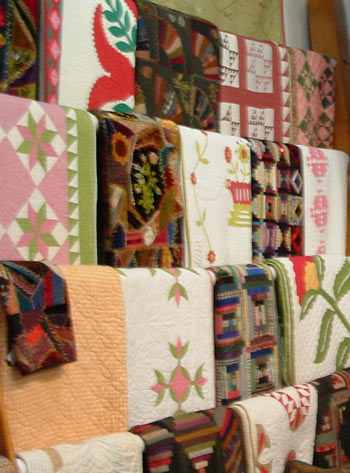How to contact Betsey Telford-Goodwin's Rocky Mountain Quilts:
Telephone - for orders or questions - 1-207-363-6800
FedEx - 130 York Street York, Maine 03909
Email - betsey@rmquilts.com
Antique Quilts - For collecting and enjoyment.
Many people look at the possession of an antique quilt as something to be afraid of. This is not true. An antique quilt is an exciting addition for any collector. Watch and enjoy as a quilt changes your environment.
By Betsey Telford-Goodwin

A wonderfully executed antique quilt brings an emotional and visual effect to one’s home that no other art form can replicate. The colors, graphics and the fact that quilts are both dimensional and tactile combine to create an incredible work of art.
Many people look at the possession of an antique quilt as something to be afraid of. This is not true. An antique quilt is an exciting addition for any collector. Watch and enjoy as a quilt changes your environment. One surprise is how this textile with its warmth and color can actually change the acoustics in a home or office. Your quilt is truly multifaceted.
There are certain basic rules when being the keeper of an antique quilt, such as, if it is on a bed, no red wine, pizza or chocolate ice cream for snacks. One sleeps under an antique quilt, not on top of it. If you choose to lay on the bed for reading or simply untying your shoes, just throw the quilt back. If the quilt is warmer than you wish on your bed at night, you do not even need to fold it. Find a wonderful fabric-lined basket and just drop it casually into the receptacle at night; the next morning, return it to your bed.
All quilts need to be washed by hand; they should never see the inside of a washing machine. Where one does not sleep next to an antique quilt, washing is done very infrequently—many times years apart.
80% of all quilts that leave my shop end up as artwork (which they are) for the adornment of a wall. Whether it’s a family room, a dining room, a front hall or an office, they are incredibly graphic and warm, evoking positive feelings. Once quilts are on the wall, they do not need to be washed as they are not being used as a sheet. Mounting on the wall needs to be done in a curatorically correct manner. Pockets should be sewn on the quilt back, top and bottom. A flat piece of finished wood (painted or polyurethaned) is slid through the pocket and secured to the wall. Never put an antique quilt or any textile behind glass. Moisture and humidity can gather behind the covering and over time will disintegrate the textile. Antique fabrics are created of natural fibers that need to breathe. Antique fabrics are either cotton, linen, wool, silk, or a combination of these. Antique quilts have lived for hundreds of years without any heat or cooling and many, many have survived (thank heavens there were no washing machines!). We are not all lucky enough to have climatically controlled rooms for our textiles—it is okay!
One basic rule for your antique quilt is to never place it in direct sunlight. Direct sunlight is not good for any fabric, whether it is a new sofa or an antique quilt. There are certain vegetable dyes where the color will not change, but most dyes will be directly affected by sunlight, and in addition it is not healthy for the fabric itself.
Quilts are dated by their newest piece of fabric and the thread used in the construction and quilting. Certain threads were made during certain eras. If someone has stated that a quilt is c.1830 but the thread dates to c.1860, then obviously the quilt is newer than they realized.
It is rewarding to be the keeper of an antique quilt. The vegetable or analyne dyes, the graphics, the history and the sociology which are behind all of these antique quilts, is amazing. Antique quilts are a study of early American life and the development of our country. If we “listen”, they all tell stories. The more you learn about the quilts, the more you understand the story that each piece is relating to us.
